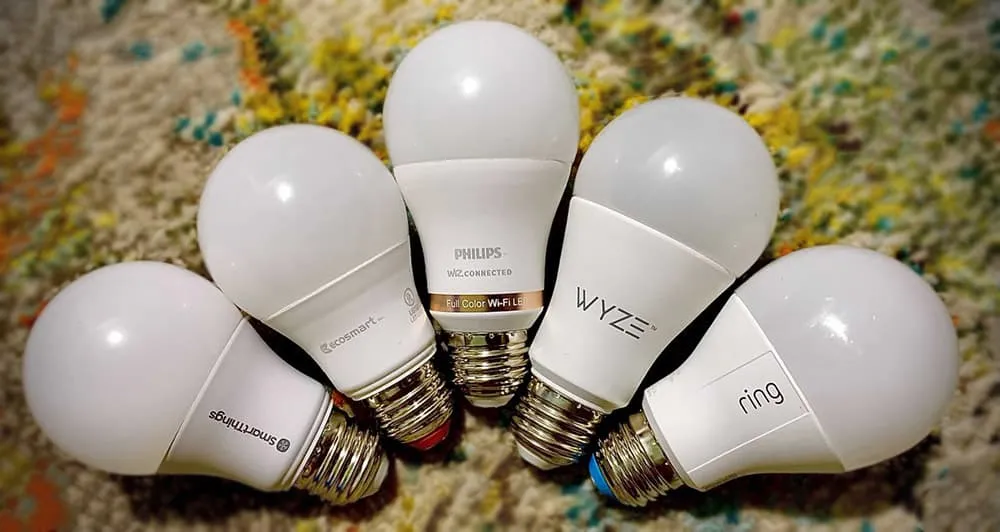
Smart lights are a popular starting point when first building up a smart home. It’s where I started, and a good place for you to start as well. It is reasonably affordable, and can be as easy or as complex as you make it out to be.
What Do You Need To Use a Smart Bulb? To get started with using smart bulbs you only need two items: A smart bulb, and a reliable internet connection. There are various means that you can use to connect your smart bulb to the internet. Everything else, such as voice assistant control and color changing bulbs, are add-on features.
Now that you know the bare minimum, let’s take a look at more of the underlying details.
What Are Smart Bulbs?
Smart bulbs, sometimes called smart lights or smart light bulbs, are LED lights that are able to be controlled wirelessly. This means it can be controlled by a phone or automation, not by using a switch on the wall (More on that later). This allows the smart bulbs to be customized, automated, and scheduled to turn on and off at given times. The most basic smart bulbs just allow the user to turn them on and off, but most smart bulbs allow the user to control brightness, and a subset allow the user to control the color of the light as well.
Chances are if you made it to this page, you already know what a smart bulbs is, and so far haven’t taught you anything. I have included the info for the complete newbie to smart bulbs. Hey, we all have to start somewhere.
How do smart light bulbs work?
So far we know the basics. Smart bulbs can be turned on and off wirelessly. But how is that implemented?
What do I need to use smart bulbs?
To use a smart bulb you will need some sort of wireless connection to the bulb, which may require a hub if the bulb uses Zigbee or Z-Wave, and a device, such as a smart phone, to control the smart bulb.
You will also need to supply the bulb with a constant power supply.
Let’s take a look at those wireless connection types in further detail below.
Smart Bulbs Wireless Connection Types
Smart bulbs use a wireless radio to send and receive their signals and messages. The type of radio used is where the differences come into play.
Just about every household has a WI-Fi router in their house. If you’re not using a wire, then you are using Wi-Fi. Some smart bulbs use Wi-Fi, which can usually connect directly to your router.
Other smart bulbs use Zigbee or Z-Wave, which require a hub to translate the message before sending/receiving from your router. There are advantages and disadvantages to each.
Smart Bulb Options: With and Without a Hub
Alright, so far we know that there are different types of smart bulbs that communicate using different types of wireless protocols. These protocols are primarily WI-Fi, Bluetooth, and Zigbee. These communication protocols are further described below, and categorized based on if a hub is required or not.
No Hub Required
Wi-Fi
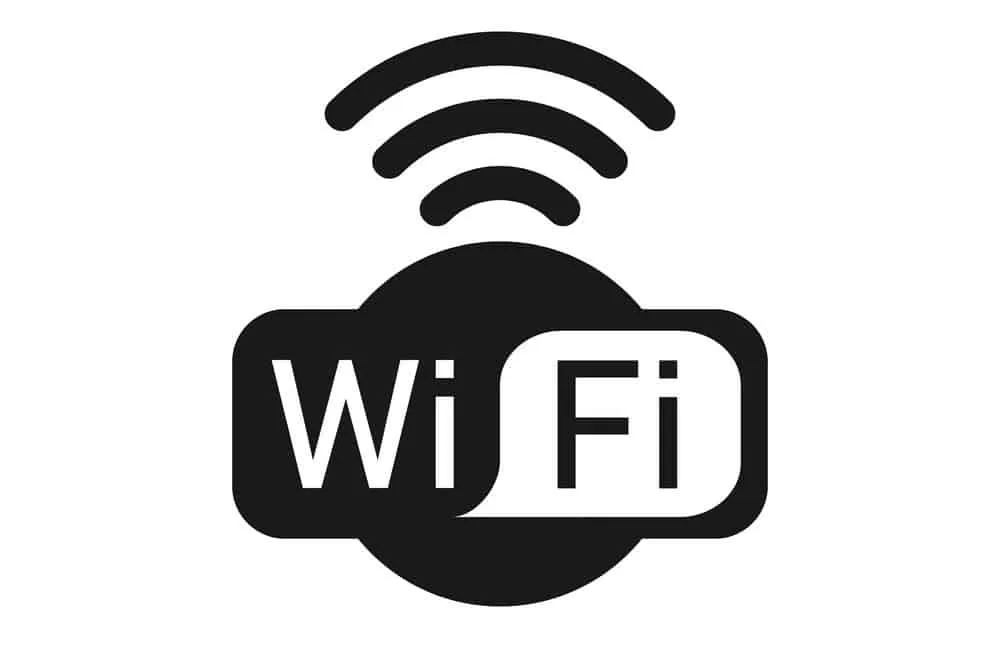
Almost every home in a America has a router that creates a Wi-Fi network. Wi-Fi provides wireless network connectivity to Wi-Fi enabled devices as long as they are within range. From a smart bulbs perspective, Wi-Fi creates a local network for your Wi-Fi smart bulbs and other smart home devices to communicate with the outside world, and therefore be controlled remotely.
Any time a device needs to communicate, either by sending information or receiving information, it will use Wi-Fi data to achieve the task.
Bluetooth
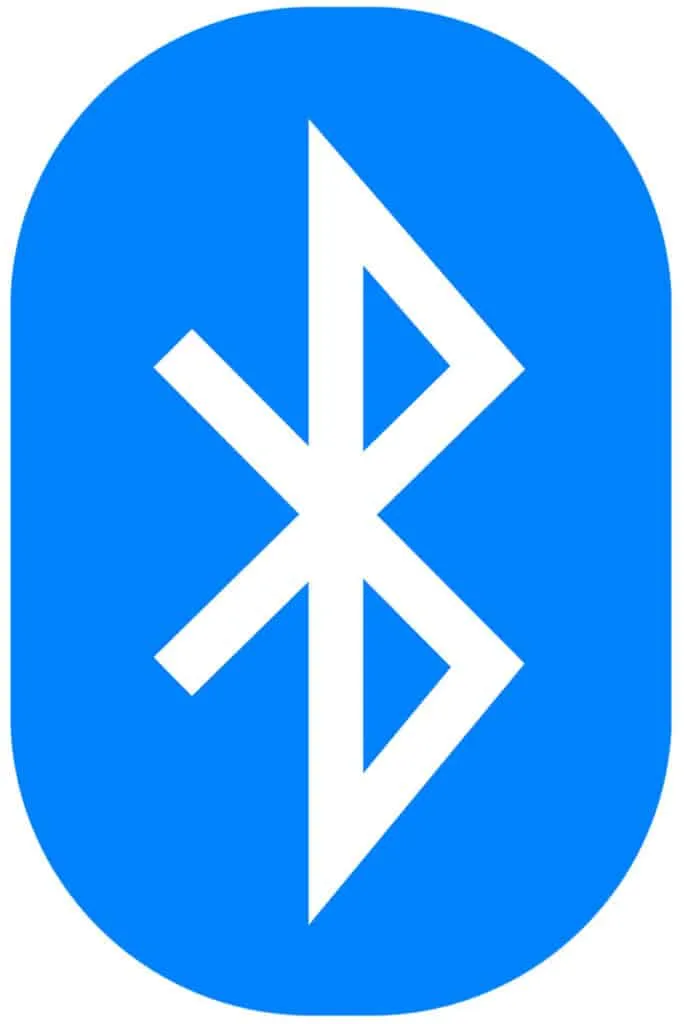
This is another type of communication method that most Americans have access through their phones, probably even more so than Wi-Fi. Just about everyone has a smart phone, and almost all of those have Bluetooth radios. That’s the reason they started making smart bulbs that are controlled by Bluetooth.
A Bluetooth smart bulb can be controlled by your phone, when it is within range. That can be viewed as a benefit or a downside. It means there is no control of the bulb if you walk out of range, which is typically a matter of feet when it comes to Bluetooth. Somewhere around 20 feet, depending on walls and other obstacles around the house. The benefit is that it can only be controlled from within the house, and no where else.
More benefits when using Bluetooth is that it is easy to setup and doesn’t add congestion to your Wi-Fi network. It can be simply controlled from your smartphone, and it uses less energy than Wi-Fi.
Hub Required
Zigbee (and Z-Wave)

ZigBee and Z-Wave are the most common Wi-Fi alternatives. They create a network similar to Wi-Fi, but using a different radio frequency. Devices that use ZigBee or Z-Wave create what is known as a mesh network. A mesh network is a wireless network where each device can talk to each other, which helps to expand the network’s range.
This is opposed to a Wi-Fi network, where each device can only communicate with the router, and the router forwards the message to the appropriate device.
In order for you to use your phone or computer to communicate with aZigbee and Z-Wave device, a smart home hub is required. Smart home hubs can connect to the cloud (aka, the internet or outside world), or they can be setup to operate only on a local network. Smart hubs sometimes have the option to connect directly to a router via a Ethernet cable, but they will usually connect using a Wi-Fi connection.
Zigbee vs Z-Wave quick review: Zigbee is faster than Z-Wave because it operates at a higher frequency, but conversely, that means Z-Wave has a further range per device. This typically doesn’t matter though, since they both create mesh networks, where each device on the network also expands the range of the network.
Zigbee can support tens of thousands of devices on a single network, whereas Z-Wave can only support a few hundred.
There are currently more than 2,500 Zigbee devices available on the market, and that list i growing all the time. These devices include just about every type of smart device, from smart bulbs to motion sensors, as well as smart plugs, water shut-off valves, and more.
Hub Optional
Zigbee & Bluetooth
Lately, the trend is to combine two types of network communication into a single smart bulb, making it more versatile. Bluetooth targets users that want to quickly setup a few bulbs (Philips Hue Bluetooth Smart Bulbs currently support up to 10 bulbs), and don’t need all the features that can be obtained from going through a hub.
Zigbee targets users who need more bulbs, or who want bulbs throughout the house, or want control beyond the four walls of their house. Philips Hue currently allows more features to be controlled through Zigbee than it does through Bluetooth.
What is a Hub?
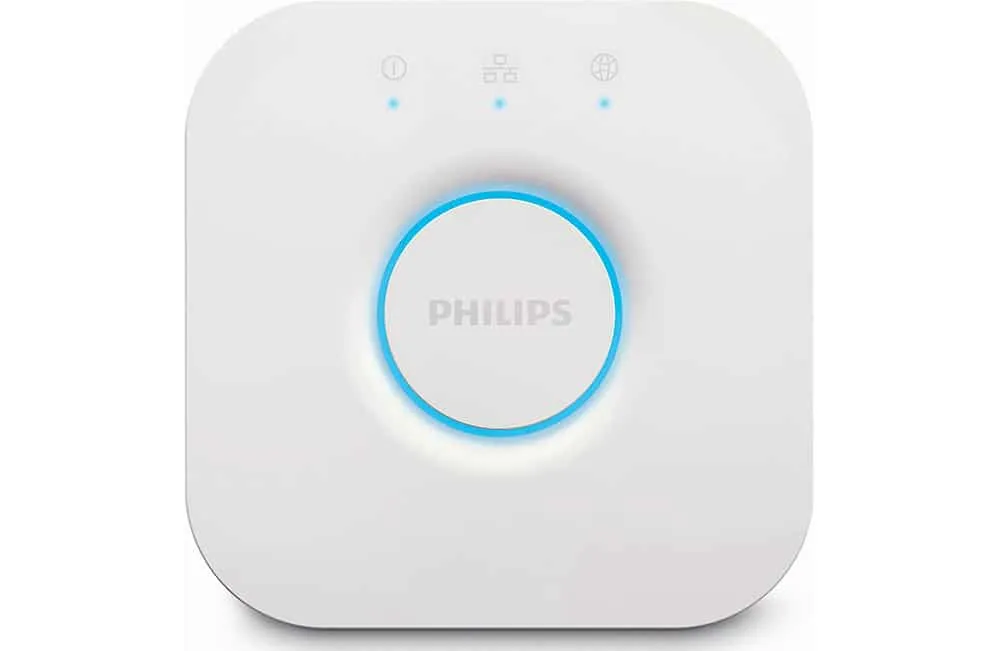
I’ve been talking a lot about smart hubs. So, what are they?
A Smart Hub, also sometimes referred to as a Bridge, is a piece of hardware that connects all your smart devices onto one network, and is able to control communication between them. Smart hubs are useful for smart bulbs (and other smart devices) that use Zigbee or Z-Wave, instead of using Wi-Fi.
The way it works is a smart hub receives a message from one device, determines where the message needs to go, and translates that message to the proper communication protocol before sending it to the end device. The smart hub is usually connected to the internet, allowing message to be sent to and from a phone or other Wi-Fi devices.
For example, if you have Philips Hue smart bulbs, which commonly use the Zigbee protocol, and you want to control them from the app in your smart phone, you will need a smart hub (Philips calls their smart hub the Philips Hue Bridge). The smart phone sends a message over the Wi-Fi network, which is received by the smart hub, is converted to a Zigbee message, and is then sent to the smart bulb. The smart hub is like a translator that knows 2 or more languages and acts as an interpreter.
When Do You Need a Hub For Your Smart Bulbs?
Not every home is going to require a smart hub, but it is something you want to think about before you start buying devices haphazardly.
How Big do you Plan to Build your Smart Home Network?
If you only plan to have a few devices (under 20 or so), than a Wi-Fi network will work just fine for you. If you plan to replace every bulb in your house with a smart bulb, then you will probably want to use a hub or risk severely diminishing your Wi-Fi.
Make sure to consider other smart devices you have or may have in the future as well. Will they use Wi-Fi or some other communication protocol? It’s okay to have some devices on Wi-Fi and still have most of your other smart devices go through a smart hub.
The key is that you want to avoid congesting your Wi-Fi network, which will cause it to run slow. It could potentially get so congested that it becomes inoperable until some of the devices are removed..
How Many Different Smart Device Brands Do You Plan to Use?
If you plan on using only one brand of devices, you can probably get away with not using a hub (unless you choose Philips Hue, which needs a hub). With only one brand, all of your devices can be controlled through one app.
Notice I said devices, and not just bulbs. It’s pretty common to have different brands of smart devices scattered throughout the house. There is not a single brand that produces smart thermostats, smart bulbs, smart locks, etc.
If you have multiple brands of smart devices, that means you will need multiple apps to control each of them. That is one of the conveniences of using a smart hub. The smart hub provides centralized control over all your smart devices from one user interface or app.
Things To Consider Before Buying Smart Bulbs
Communication Type
I’ve covered communication type in detail already, but here are some factors to consider when choosing which one you want to use.
Out of the communication protocols I’ve mentioned, there are two main protocols that smart bulbs use to communicate with the outside world. Wi-Fi and Zigbee. Z-Wave is also a third option, but Zigbee seems to be winning out over Z-Wave. So, you probably don’t want to use Z-Wave unless you have a specific reason.
If you plan on using a lot of smart bulbs, or having several smart devices in your home (upwards of 20+), consider using Zigbee.
With WI-Fi, interference, or wireless congestion, can occur when there becomes too many devices operating on your local Wi-Fi network. If interference starts to occur, you may notice that the speed of your internet connection has slowed down to a snail like pace. You may start to notice a slow down with around 20-30 devices on the network.
Zigbee on the other hand can support over 60,0000 devices without slowing down. In fact, more devices help expand the Zigbee network, because it is a mesh network, which I explained earlier.
Zigbee devices require a hub. That hub will connect to your WI-Fi, or be hard wired to your router. If connected via Wi-Fi, it will only be one device connected to the router, instead of many, therefore avoiding interference issues.
Choose How you Will Control your Smart Bulbs
As I mentioned earlier, each brand of smart device you buy will have their own app. Unless you go through some additional setup, buying more than one brand means you will end up having to use multiple apps to control the various brands.
You don’t have to worry though. There are apps, programs, and voice assistants that are designed to help take care of that problem. However, not every brand is compatible with every app, that is why you have to spend a few minutes planning how you are going to control your smart bulbs.
The most popular voice assistants are Google Assistant and Amazon’s Alexa, with Apple HomeKit starting to make an entrance. The smart bulb packaging will prominently display which ones it is compatible with, usually in the form of a rectangular logo somewhere on the box.
The other option is a single app that is able to control all your smart devices in one place. There are several options for this, but one the most common option is called IFTTT Stands for IF This Than That). Again, compatibility is usually displayed on the packaging of smart devices.
One of the benefits of connecting all your devices to an app like IFTTT is that is makes home automation much easier. You can do things like use smart bulbs when certain events happen on other smart devices, like your smart video doorbell, smart thermostat, cameras, etc.
I highlight some ideas for those automatons below, in my list of practical uses for smart bulbs.
Where can I use smart bulbs?
Smart bulbs can be used in almost any household fixture where a light bulb was previously used. There are many different socket types, which must be matched. There are a few applications where a regular light bulb is so small or is in a special environment, that making a smart bulb isn’t possible.
The first place that comes in mind where you would not be able to use a smart bulb is in a microwave. A microwave wreaks havoc on wireless communications, plus the smart bulb would have to use special materials so it wouldn’t melt when the microwave was in use. Plus, who needs a smart bulb in the microwave!?
Keep the following in mind as well. Smarts bulbs cannot be used with a dimmer switch, as the bulbs are designed to require a full 120 V power source.
Alright, lets take all that information and put it to good use. Here are some ways that you can use smart bulbs around that house.
1) Set Visual Alerts
It possible to set your smart bulb to change color when an certain events occurs and are detected by your other smart devices.
For example, did you ever leave the house and forget if you locked the door as you were starting to drive away in your car?
Now there is a way to get rid of the annoyance of pulling the car back in the driveway, getting out, and walking to the door just to find that you did remember to lock it.
If you have a smart lock on your door, you can program a smart bulb to change to a certain color, for a certain period of time, as a visual indicator that the door is indeed locked.
Then again, it is a smart lock, so you should be able to open the app and check if the door is locked, but in my case I don’t have cell phone signal when I leave my house.
In any case, a light is a quick visual way to be notified.
2) Outside Weather Notification
Houses today are pretty well insulated, and looking out the window may not be the best way to tell if it’s hot or cold. Have you ever been inside for a day or two and then go outside and get shocked by the weather? I know where I live, the weather can have big temperature swings from day to day, or even within a day itself if a cold front is rolling in.
The solution to this is having a smart bulb change color based on the temperature outside. Maybe have it located by the door, or someplace that you will notice before going outside.
An app such as IFTTT can be used to turn your lights blue for cold weather, red when it gets hot, and go through the gradient based on the temperature. And since you get to do the setup, you can define what cold and hot are and everything in between. I live in Texas, so I might have a different opinion on cold as opposed to someone who lives in Canada.
3) Bedtime Routines
This use case could go a couple different directions depending on how you want to prepare for bedtime.
The first use is to program the lights to start getting dimmer at a certain time of day. This may not work if you don’t have a normal routine, but if you have a job you have to wake up for at the same time on a routine basis, then you could program the lights to start dimming at a certain time at night to help ease you and encourage you to go to bed.
That could also work for those of us with children as well. An indicator to the kids that its bedtime.
This could also be flipped around for when it’s time to wake up and get out of bed. Slowly increasing the brightness of the lights to gently wake you up like a sunrise.
The second use is to turn off all the lights when you go to bed. You probably don’t want this to be an automation, but rather a push of the button on your phone once you are in bed.
Now you never have to worry about getting back out of bed to go turn off a light you forgot about. Just grab your phone and hit a button. Everyone sleeps with their phone within arms reach, right?
4) Flashing For Phone Calls
I’m often busy doing things around the house and I tend to leave my phone laying in random spots while I’m at home. Sometimes in random places, like a shelf in the garage if I had been working out there.
Now when you receive a call from a certain phone number, you can have your lights flash a certain color for that person. You now have a way to know who the call is from, and also a way that makes sure you don’t miss their call. Or if you do miss it, you at least know you received a call.
Also, you can have the lights set to a certain color for an unknown number, or just not change color at all if you prefer to ignore unknown numbers.
5) Night Lights
Again, this is a couple practical uses cases under one heading.
The first use is the obvious one (at least to me) based on the name “Night Lights.” Yes, I’m talking about the good ole’ fashioned night light, but now it has a twist.
A smart bulb allows you to set the night light to the exact brightness you need, and to your desired color. That solves the main problem I always had with night lights. I always found them to be too bright, and they would end up keeping me awake. That’s not a problem anymore, as I can set the smart bulb to be very dim, and to a soft warm color.
The second practical use for night lights is to setup an automation where the lights turn on when you get home. It doesn’t necessarily have to be at night, but that seems the most practical to me to have lights turn on when it’s dark.
Personally, I have lights setup to turn on when my phone picks up my home network, but there are alternative options, such as using geofencing, to have the lights turn on when you get within a certain distance of your house.
Keep in mind, it doesn’t have to be just inside lights that turn on. You can use smart bulbs outside as well to light up around your house to increase security or just help light your way.
6) Security
A lot of crimes occur under the cover of night, and there’s no better deterrent than a light turning on. That makes smart bulbs a great compliment to your home’s security system. If your camera picks up motion in a certain region, a light can be triggered to turn on and light up that area.
Multiple regions can be setup using as many cameras as needed, triggering your smart lights to turn on and blanketing the area with light. Alternatively, smart motion detectors can be used as a cheaper option to cameras, or where it doesn’t make sense to place a camera.
Another method that’s been used since electric timers were invented is having lights turn on and off at random times. This is extremely easy to do using smart bulbs. This is a great feature to use when you are on vacation, so it makes it look like someone is actually home.
7) Entertainment
Smart bulbs may come across as a novelty item still. The idea to use them as entertainment is pretty heavily marketed, but there are a lot of great, functional ideas under this category.
Perhaps you are about to watch a movie. Set your smart lighting to the perfect level that for the room you are in. Or you can make it feel like you’re at the movie theater and fade the lights to black once the movie starts.
What about holidays? Light up your house in green and red for Christmas, orange for Halloween, an array of pink for valentines day, or all green for St. Patrick’s day. It’s a fun and festive way to set the mood, and one the kids will surely appreciate.
What about those holiday parties? When you are having a party at your house, set the lighting to match the color theme, or you can change colors throughout the party randomly or based on events happening during the party. Or you can set a party mood by having the lights switching through a variety of colors like a strobe light.
8) Light Switches Where you Want
Having the option to control your smart bulbs from anywhere through an app or home automation, or even your voice is great, but sometimes its nice just to have a switch that you can hit real quick.
That’s another feature that smart bulbs provide us. A switch can literally be placed anywhere in the house, and be able to turn on and off whatever smart bulbs you programmed it to control.
Ever been in a house where the placement of the light switches don’t seem to make sense? That’s not a problem anymore when you use smart switches to control your smart bulbs.
Switches no longer have to be in fixed positions on the wall, and the most advanced smart switches don’t even have to be wired. If you’re worried about powering the switch, some of them don’t even require a battery! They just use the energy generated from you pushing the switch.
9) Know When The Mail Arrives
This one requires a little bit of tinkering. Start by placing a motion sensor in the mail box, and it’s now a smart box. Once you have received the mail, you can have one of your smart bulbs change color or turn on to notify you that “You’ve Got Mail!”
I’m probably aging my self by using the movie reference. I bet most smart bulb users won’t even get that reference.
Do smart bulbs work with normal switches?
Yes, a smart bulb can work with a normal light switch, but it’s not recommended. Light switches that provide power to a smart bulb should be left in the ON position. Smart Bulbs require a constant power supply in order for their smart functions to work. If you are worried about wasting power, leaving the light switch on uses very little energy. In the end though, turning the switch off does not hurt the smart bulb if the smart features are not needed.
How do smart bulbs work with Alexa and other Voice Assistants
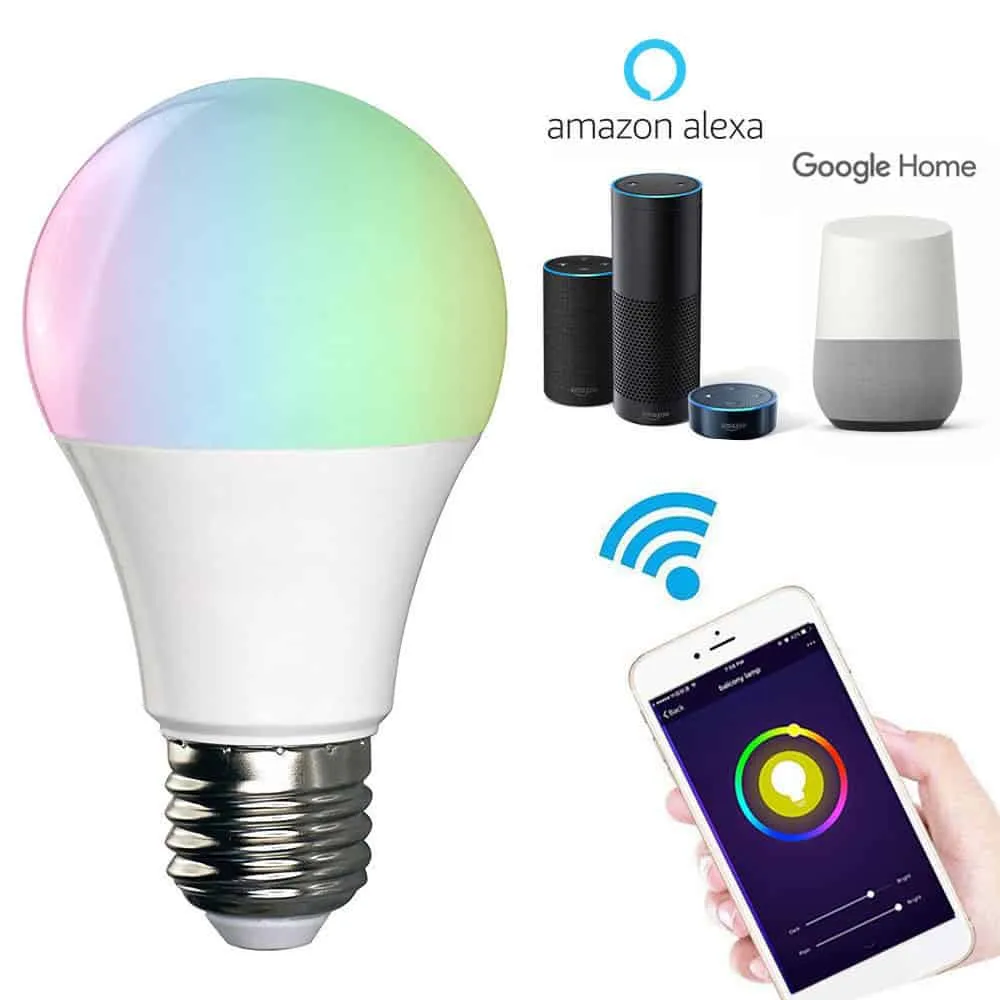
If you have a smart speakers already, make sure that the smart bulb packaging indicates that it is compatible with Alexa, Google Home, or whatever brand you have. You can go ahead and buy your smart bulb and rest assured that it will work.
Setup is fairly straightforward, as long as you know what phrase to use with Alexa. Take the smart bulb home, power it up, and say, “Alexa, discover devices”. The device should be discovered, where you can then give it a name, and then you an use that name when telling Alexa to turn the bulb on or off..
Here’s instructions straight from Amazon on how to pair a smart device with an Echo.
Other smart speakers and voice assistants follow similar methods for adding devices, although the commands will be unique for each voice assistant.
Summary
In summary, there are two important things you need:
- A Smart Bulb
- An internet connection
That internet connection may be through Wi-Fi, or it may be through using a hub that is then connected to the internet.
Simple as that!
